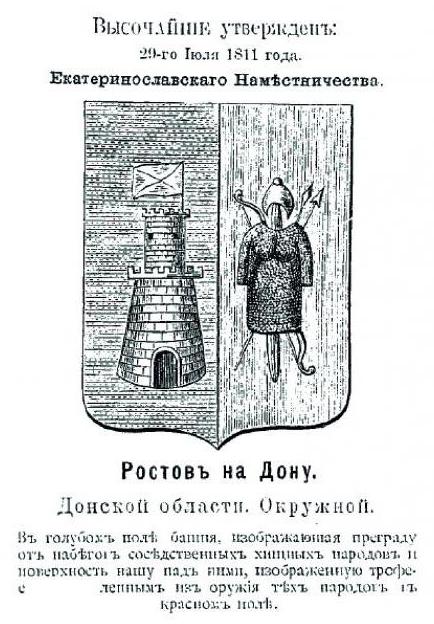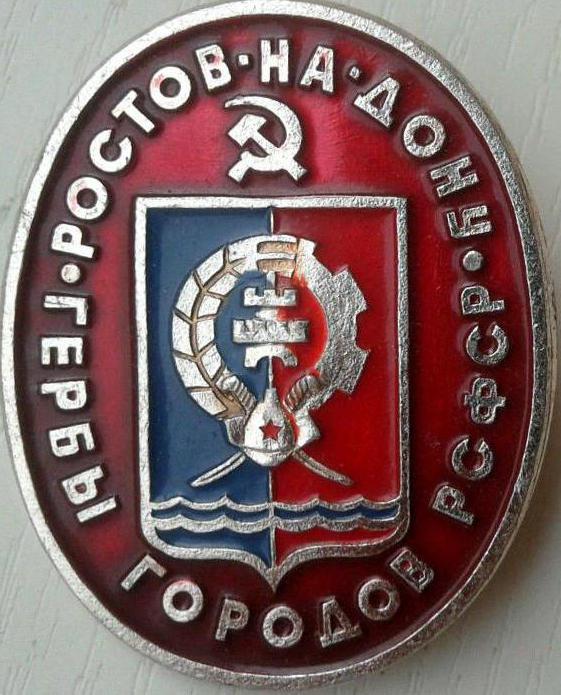In the Russian Federation, the rules for the compilation and use of official symbols are established by the President’s Heraldic Council. In order for the use of the city coat of arms or flag to be legitimate, it is necessary to coordinate it in the council and make it into the State Heraldic Register of the Russian Federation.
Today, not all symbols have passed such a registration. The largest city in the south of Russia, Rostov-on-Don, does not have an officially approved symbol.
The emblem of the Rostov region is entered in the register under the number 214, but the symbols of its administrative center do not have such registration. The reason is the complex history of its creation and use in different historical periods.
Empire's southern outpost
Protecting the southern borders of Russia, the struggle for access to the Black Sea has long been an important task for the Russian autocrats. During the Azov campaigns of Peter I (1695-1666), the history of the city began, which became one of the main centers for the development of the southern territories of the state. The official date of the founding of Rostov-on-Don is the decree of Catherine II on the establishment of customs at the mouth of the Don tributary of the Temernik River to collect duties for goods exported to southern countries, and for imports, mainly Turkish.
The defensive citadel and the center for collecting trophies and trade duties - such an appointment was originally Rostov-on-Don. The coat of arms of the city has become an expression of these functions. At the beginning of the 19th century, Rostov was part of the Yekaterinoslav governorate and, among its other subjects, received the highly approved coat of arms. His image, listed in the Complete Collection of Laws of the Russian Empire, was reproduced in 1899 by the famous Russian heraldist Pavel Pavlovich von Winkler in the album "Coats of Arms of the Cities, Provinces, Regions and Posadas of the Russian Empire".
Coat of arms of Rostov-on-Don
On August 2, 1811, in the framework of the administrative reform carried out by Alexander II, the emblem of Rostov-on-Don was highly approved. The description (the term blazon was adopted in heraldic practice) contained elements denoting the main purpose of the city. On the azure (blue) field there was a two-tier fortress tower with closed gates at the bottom and two loopholes at the top, crowned by the St. Andrew's flag waving to the left. It meant a barrier from the raids of the southern neighbors. In the scarlet (red) field - trophies won in battles with them: a helmet and chain mail against a background of crossed combat bow and spears.

The description was not completely compiled, which subsequently gave rise to several informal options. For example, banners were required for regiments that had a place of deployment in Rostov-on-Don. The coat of arms compiled by the historian A. A. Skalkovsky, which was used in them, was significantly different from the 1811 version. In it, the vertical section of the shield was replaced by a transverse intersection, the pattern and location of the tower and armor changed. A symbol of the Yekaterinoslav province appeared on the shield - the monogram of Empress Catherine II surrounded by stars. The coat of arms was supplemented by a tower crown and ears, entwined with a red Alexander ribbon.
Status change
At the beginning of the 20th century, among other large settlements of Russia, Rostov-on-Don also received the rights of a separate city administration. Its emblem was changed in accordance with the new status. According to the rules developed by the prominent heraldmeister Baron Bernhard Köhne, the shield was crowned by the ancient Tsar’s crown, framed by its golden oak branches, which were decorated with a red ribbon of the Order of St. Alexander Nevsky.
In 1904, an improved coat of arms was approved. Uncertainty remained in the outlines of the tower and trophies, in their color scheme. In this form, it existed until 1917 and became the basis for the Rostov coat of arms, restored by the city authorities in 1996. In Soviet times, a completely different symbol was used.
One of the best Soviet emblems
Deprived of all pre-revolutionary symbols, like all Soviet cities, Rostov-on-Don found a new one only in 1967. After the competition was announced, an option was developed that was developed by artists B. M. Shanibov and V. M. Kozhemyakin. From the old city symbol, which was proposed to be taken as a basis, the Soviet coat of arms of the city of Rostov-on-Don inherited only a vertical division into blue and red fields, a tower and the presence of weapons, which acquired a completely different meaning.

The new city emblem was actively used in practice and was considered one of the most expressive in Soviet times. The coat of arms, the photo of which adorned numerous tourist materials, was well known to residents and guests of the city. The main element of the coat of arms was a circle formed from stylized ears on the left and part of the gears on the right. In the center of the circle is a battlement, transferred from the historical coat of arms. In the lower part of the circle there is a budenovka against the background of crossed sabers. The lower part of the shield is intersected by two wavy lines that personify the main river of the region - Don.
Restored symbol
In 1996, the city government restored the coat of arms of 1904. But the description approved by the City Duma contained a number of deviations from the historical version, which does not allow it to be agreed upon in the Heraldic Council. This applies to the color of oak leaves - according to the rules of heraldry, they can be green, as in the accepted description, only according to special instructions according to the type of city administration given to the city at the beginning of the century, a more acceptable solution is a golden color.
Clarification and color require the basic elements - towers, chain mail, weapons that fill the Rostov coat of arms. A photo of the symbolism used in practice shows how an incorrect description can be interpreted differently.
The city, which left a noticeable mark in the history of the country, playing a large role in the development of its southern region, deserves a more careful attitude to its symbols.